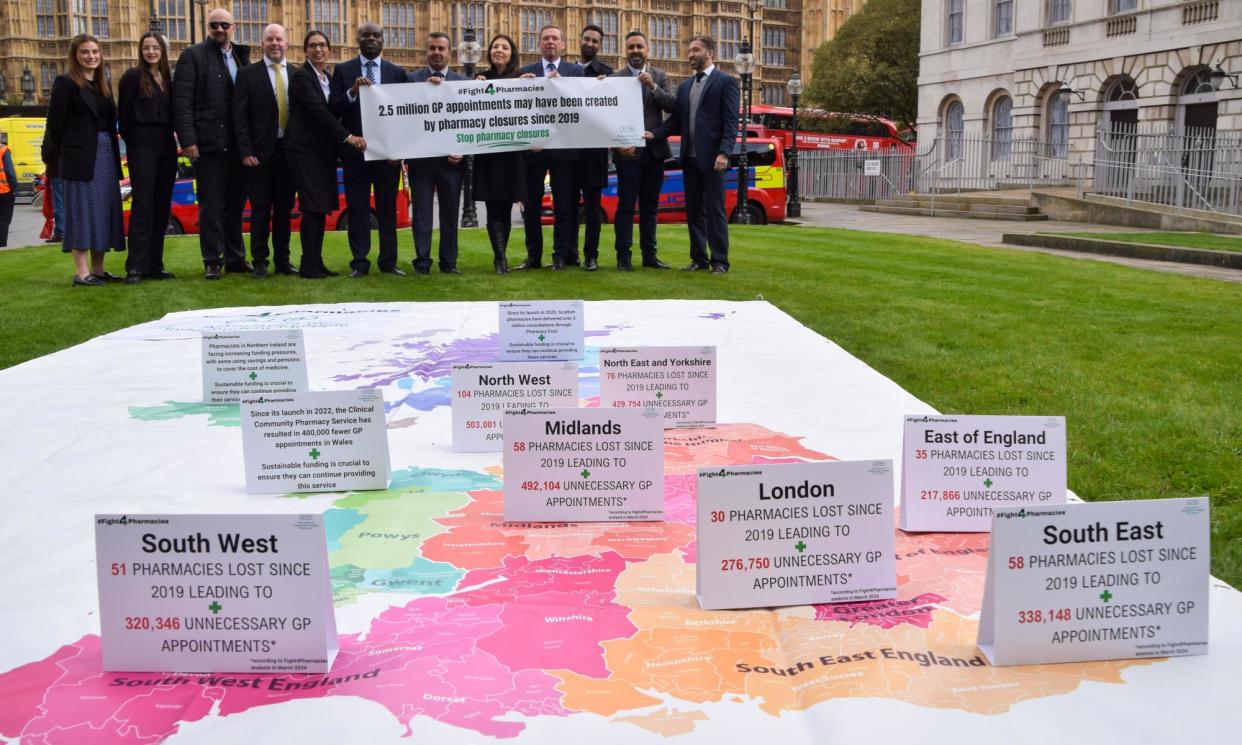Nearly 1,000 pharmacies in England closed since 2017, with poorer areas more affected

Almost 1,000 pharmacies in England have closed since 2017, potentially leading to millions of extra GP appointments, the Guardian can exclusively reveal.
There are more than 11,000 pharmacies in England. Guardian analysis of the official register of these chemists has found that parts of the country have lost more than one in five pharmacies in the last six years, with poorer areas experiencing proportionally more closures.
Since the end of 2017, 953 pharmacies have disappeared in England – more than 7.7% of the total. Over the same period, Wales has lost 4%, while in Scotland the numbers have remained stable. In England, the rate of closures is spiralling rapidly, the data from the General Pharmaceutical Council shows. In 2017, the number of dispensing chemists grew by 15. But last year, 372 pharmacies closed, more than three times the number that shut in 2022 and more than any year since at least 2016. In contrast, in 2023, Wales lost 12 pharmacies and Scotland six.
The figures call into doubt efforts to relieve pressure on overstretched English GP surgeries. In January, NHS England launched its Pharmacy First initiative, to encourage patients with seven common conditions to visit their pharmacist instead of their GP. The Department of Health and Social Care claims the scheme will free up 10m GP appointments a year.
The rate of pharmacy closures is adding pressure on GPs, not easing it, evidence shows.
A Guardian analysis of Community Pharmacy England figures suggests that about 5.5m GP appointments might have been saved since the end of 2018, had no pharmacies closed since then. The conservative calculation – based on the estimated number of appointments that might have been saved by the patients going to a now-closed pharmacy instead – suggests that nearly 1m GP appointments might have been avoided last year alone.
In the local authority area of Woking, the number of pharmacies has fallen by a third in the past six years, , while West Berkshire, Exeter and Pendle have lost about a quarter. In all, 14 council areas in England have lost at least one-fifth of their pharmacies.
The regions with the most closures were the south-east, which has lost almost one in 10 pharmacies since the end of 2017, followed by the south-west (9.4%), north-east (9.2%) and north-west (8.8%). In comparison, London and the East Midlands have lost fewer than 5% of pharmacies.
Overall, the worst-off parts of England have lost 10.7% of pharmacies in five years, while the least deprived neighbourhoods lost 5.5%.
The figures also suggest that smaller pharmacy chains and independent pharmacies are being out-competed by bigger chains. In England, the figures show that 14% of pharmacies in areas containing a branch of Boots have closed since 2017, compared with a 5% decrease of pharmacies in neighbourhoods without a Boots.
Paul Rees, the chief executive of the National Pharmacy Association, said the £2bn annual core funding from the NHS did not cover the sector’s costs and many pharmacies had to borrow from family members or remortgage their homes, simply to stay open.
He said: “Thousands of family-run pharmacies are clinging on by their fingertips, but face ruin if this chronic underfunding continues. Community pharmacies are closing at a record rate and many more are approaching a cliff-edge.”
Dervis Gurol, who owns a pharmacy in Sussex, said: “It breaks my heart, because patients rely on us to provide a vital healthcare service, many of whom are elderly or vulnerable. However, we can’t continue to carry on providing that service and care for our patients if this funding crisis is not addressed.”
The rate of closures has raised doubts about the government’s Pharmacy First scheme.
Steve Brine, the Conservative chair of the Commons’ health and social care select committee, said evidence given to the committee’s recent pharmacy inquiry showed community pharmacies had great potential to provide more clinical services but that “extreme pressures threatened the very existence of some stores”.
He said: “If pharmacies are not there, they can’t deliver an extended service. Pharmacy First is a really positive thing but it’s the start not the end of the story.”
Dr Leyla Hannbeck, the chief executive of the Association of Independent Multiple Pharmacies (AIMP) and founder of the Fight4Pharmacies campaign, said: “I have to question the future viability of the Pharmacy First scheme, while so many pharmacies are closing. There is no way it is going to save 10m GP appointments when community pharmacies have been stripped to the bone by chronic underfunding. We welcome the ambition: we want to help and have the skills to do so, but unless the government improves our core funding, more pharmacies will be forced to close, leading to more GP appointments, not less.”
A Department of Health and Social Care spokesperson said: “We do not recognise these figures. If a pharmacy closes, we would expect a patient to go to another pharmacy, not a GP, and four in five people live within a 20-minute walk of a pharmacy.
“Pharmacy First, alongside the expanded blood pressure check and contraception services, will free up an anticipated 10m GP appointments a year, once fully scaled. It has been widely welcomed by the pharmacy sector and so far, 98% of pharmacies have signed up.”


